The Eisenhower urgent/important matrix
Prioritization of actions and obligations is an inseperable part of effective project management. Defining a prioritization framework supports building an impactful project roadmap.[1] Moreover, prioritizing projects requirements is needed to provide a clarified direction in order to maximize the value of the project deliverable. [2] The Eisenhower matrix, also known under the name of Eisenhower Decision Matrix, Eisenhower Box, or Urgent-Important Matrix is one of task and actions' prioritization methods designed to enhance productivity and time-management efficiency. The tool’s concept was developed by a former president of the United States Dwight Eisenhower. Eisenhower based the idea on categorizing certain items by taking into account their urgency and importance. [3] [4]
This article looks further into the Eisenhower Matrix as a Project, Program and Portfolio management method from the perspective of people and their self-management performance. Following chapters discuss historical background of the matrix, next moving to the characterization of the template itself. The specification of each four quadrants is examined. Subsequently, application of the tool both in daily life and in project management cases is presented, followed by examples. Limitations of the matrix are critically discussed. Drawbacks and limitations of the Eisenhower box are examined, considering the fact of the method’s simplicity. Therefore, the article also examines possible effects of merging the Eisenhower Matrix with other used prioritization methods, resulting in enhanced deliverables. [5] [6]. The article ends with the annotated bibliography of relevant literature and articles and other insightful readings.
Contents |
Brief Background
Dwight Eisenhower
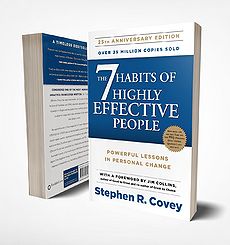
A person behind a concept of the urgent/important matrix is Dwight David “Ike” Eisenhower. He was an American military officer and statesman who served as the 34th president of the United States from 1953 to 1961. As a president of the United States he led the construction of the Interstate Highway System, created NASA, signed into law the first major piece of civil rights legislation since the end of the Civil War, obtained truce in Korea, welcomed Alaska and Hawaii into the union, and many more accomplishments. His thorough understanding of the difference between the urgent and important enabled him to succeed. In a 1954 speech, Eisenhower quoted Dr J. Roscoe Miller, president of Northwestern University, who said:
“I have two kinds of problems, the urgent and the important. The urgent are not important, and the important are never urgent.”
- Dwight D. Eisenhower, speech to the Second Assembly of the World Council of Churches[8]
The quoted “Eisenhower principle” is thought to be the way he managed to organize his priorities and workload.
The 7 Habits of Highly Effective People
Stephen R. Covey popularized Eisenhower’s framework of urgent vs. important in 1989 in his book The 7 Habits of Highly Effective People. He was a multitalented personality who was recognized for his work as a successful businessman, educator and an influential public speaker. [9] Covey's inspirational book is considered to be the psychology handbook of the '90s, the first most influential business book of the twentieth century and one of the top-ten most influential management books ever. Covey believed that the essence of the best thinking in the area of time management can be captured in a single phrase: Organize and execute around priorities. [7] As a result of Covey’s work, the Eisenhower Matrix has become a widely used time-management and decision-making framework in business. [7]
“Effective management is putting first things first. While leadership decides what “first things” are, it is management that puts them first, day-by-day, moment-by-moment. Management is discipline, carrying it out.”
- Stephen R. Covey, 1989, 7 Habits of Highly Effective People: Powerful Lessons in Personal Change[7]
Framework
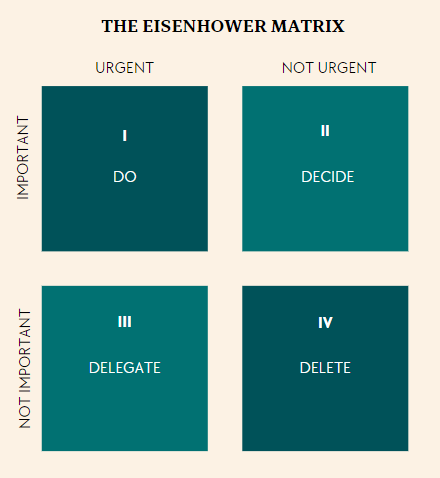
The Eisenhower matrix is a graphical diagram used in strategy and planning. Stephen R. Covey claims that people spend time in one of four ways. [7] Hence, the diagram contains four quadrants: important/urgent, important/non-urgent, nonimportant/urgent, and non-important/non-urgent. [5] According to productivity expert James Clear, you can understand the items in each of the four quadrants with this simple framework: Do, decide, delegate, and don’t do (or delete). After drawing Eisenhower Matrix, there are four empty boxes, two by two. This allows one to categorize to-do items into one of four possible directions, distinguished by Covey. [8] In order to further explore 4 quadrants of the time management matrix, definitions of urgent and important should be studied:
- Urgent equals requiring prompt attention. Urgent matters insist on action, pressing on the practitioner. They are usually perfectly visible and cause reaction. [7] Often, task order is based on the urgency.
- Important means “of great significance or value; likely to have a profound effect on success”. How one defines importance, therefore, potentially affects success. Tasks can be important for various reasons: societal, individual, organizational, etc. Importance is about the impact of accomplishing the task; bringing intrinsic benefit to someone or some group. [5]
Quadrant I
Quadrant I is both urgent and important. It deals with significant results that require immediate attention. The activities in Quadrant I are most often referred to as “crises” or “problems” with a given deadline. Tasks with clear deadlines and consequences for not taking immediate action fit into that Quadrant. [8] Quadrant I consumes many people involved in management field, such as crisis managers, problem-minded people, deadline-driven project managers. For instance,
Quadrant II
Quadrant II consists of not urgent & important. Author Stephen Covey believes that Quadrant II is the sweet spot of time management. This is the spot where you are focused not on problems (as with Quadrant I) but on opportunities and growth. Living from this quadrant of the matrix means leaving proactive and prioritizing activities that help to grow skills and energy, and contribute to accomplishing meaningful goals. Quadrant II is where “deep work” happens because the tasks are largely freed of pressing distractions. [8]
Quadrant III
Quadrant III is both not important & urgent. These are urgent items that pop up and demand instant attention. However, because they are far from being necessary, they do not inevitably require time, and they can, therefore, be assign to someone else. [4] The reality is that the urgency of these matters is often based on the priorities and expectations of others. [7] These tasks are often set by others and do not move you closer to long-term goals. Covey suggests delegating as many Quadrant III tasks as possible. [8]
Quadrant IV
Quadrant IV fits not urgent and not important tasks. They are considered to be time-wasting activities that should be ruthlessly cut out. These activities don’t contribute to progress on one's goals but can end up taking over large chunks of time. [8] Eventually, tasks that fit the Quadrant IV category ought to be erased.
Application of the Matrix
No matter if one uses the Eisenhower matrix to organize their home duties or their work duties, its application is universal. Furthermore, Eisenhower matrix is an uncomplex chart for all types of industries and departments in enterprises. It’s a useful tool for both new businesses, startups, and existing mature organizations. Organizations can implement it for either individual use for every employee or project teams.It is not limited to any dimension. To weigh priorities in the matrix, one should pose questions such as “What do I need to do right away?”, “What is wasteful and needs to be eliminated?”, and “Which tasks do I need to do, and which ones can someone do for me?” Focus during this process should be on what, instead of when. Scheduling comes easier once priorities are set. [8] [4]
Implementation in Project, Program and Portfolio Management
What can help to envision why many teams benefit from using a priority matrix is The Pareto Principle. The Pareto Principle, known also as 80/20 rule, proves that 80% of your project activities will produce 20% of the results and in parallel 80% of the results are a consequence of 20% of overall effort. [9] Firstly, by using a Pareto Chart to identify the most significant factors contributing to a problem or issue, individuals and organizations can then use the Urgent/Important Matrix to prioritize the tasks necessary to address those factors. For instance, if a Pareto Chart identifies 80% of the problems in a project, which are caused by 20% of the tasks, the practitioners can use the Eisenhower Matrix to prioritize those critical tasks and address them first.
Looking from the uncertainty and complexity perspective of project, program and portfolio management proactive exploring and responding to any uncertainty is tremendously relevant. Risk responses are directly aligned with prioritization of project constraints, such as: budget, schedule, and operational performance. Projects that stick to incremental approaches can have high-level themes that are decomposed into features, which are then further decomposed. Workload that is unique, significant, risky, ought to be prioritized with the Eisenhower Matrix to reduce the uncertainty associated with project scope at the start of the project before significant investment has taken place. "Projects may have a product backlog, a requirements backlog, impediments backlog, and so forth. Items in a backlog are prioritized. The prioritized work is then scheduled for upcoming iterations." [2] "Project teams plan routine work based on the concept of last responsible moment. This approach defers a decision to allow the project team to consider multiple options until the cost of further delay would exceed the benefit. It reduces waste by not expending time in developing plans for work that may change or may not be needed." [2] Utilizing the Eisenhower matrix is an answer to the discussed challenges.
In project management, prioritizing stakeholders' needs is essential for the success of the project."Certain stakeholders, such as the product owners, play a substantial role in establishing and prioritizing work."[2] To prioritize stakeholders' needs using the Eisenhower Matrix, project managers need to first identify and categorize all stakeholders involved in the project, program or portfolio managament and their respective needs.
To conclude, unquestionably there are limits to its use, discussed in the succeeding chapter. Nevertheless, any project, program, portfolio management practitioner can to some extent make use of the Eisenhower Matrix. The Figure below shows questions one can ask themself in regards to project, program, portfolio managament to analyse the urgency and importance of given agent.
Practical Guidelines
In order to create a project prioritization matrix one should follow the steps listed below:
- Step 1: Create a task list: Compile the list of items/activities/tasks to prioritize. Project backlogs should have the priority. Make sure that everything is up to date. You can utilize a Kanban Board, if one is created. Kanban Board indicates which tasks are still pending and waiting for realization.
- Step 2: Analyze each task list: After compiling a list, rank tasks basing on the criteria of urgency and importance. Apart from a status category in the Kanban Board, you may add the urgent/ non-urgent and important/non-important category to your Kanban Board to facilitate categorizing into certain quadrants.
- Step 3: Plot tasks into the Eisenhower matrix.: Place each task into specific quadrant out of all 4 based on the pre-defined categories.
As follows, examples of tasks belonging to specific quadrants are listed out:
- Quadrant I, Do: project deadlines, product shipments, client complaints, last-minute presentations.
- Quadrant II, Schedule: strategic planning, continous improvement, creating training materials.
- Quadrant III, Delegate: reporting, non-critical meetings, pending emails.
- Quadrant IV, Delete: duplicated tasks, no value added tasks.
Drawbacks and Limitations
For one, the Eisenhower Matrix is an uncomplicated time management tool to prioritize actions or tasks based on importance and urgency factors. Just like every method or tool has its benefits and drawbacks, a few disadvantages of the matrix can be indicated. While its simplicity makes it undemanding to use, it overlooks other crucial factors, such as availability of resources, workload, complexity of tasks, or level of effort a task is requiring.
The tool is not devoid of subjective judgement. Every person, no matter the circumstances, has a tendancy to observe and analyze the world from the perspective they're most familiar with. That also applies to any employee, project manager, director. To assign priorities realistically and objectively, situation should be approached with a fresh perspective, while avoiding individual preferences. People who haven't been involved in past efforts and are not biased should be included in the process of prioritization.
Without the option to delegate tasks, there is less distinction between urgent/important and urgent/not important. If one is not in charge of their own schedule, they will not be able to prioritize the order of their tasks, and will likely spend the majority of their time executing someone else's tasks from the Quadrant III. That may require expending the matrix by regarding the fit factor, which treats about the capability of the user to perform a task and if not, delegating it further. This topic is discussed in the chapter 5.2.
What is more, the Eisenhower Matrix grid can be insufficient if too many tasks are present. Its best use is when there are relatively few tasks per quadrant, approximately 5 a piece. The higher the volume of tasks, the more overwhelming it can become. Users will must require further prioritization activities within each quadrant. Therefore, when there are many activites to be prioritized, the Eisenhower Matrix may only be in use as a preliminary prioritization method.
Merging with other Prioritization Methods
This chapter is aimed at discussion and examination of possible merging of the Eisenhower matrix with other prioritization methods. As discussed in the chapter 4, The Eisenhower matrix entails various limitations. Overcoming them may be facilitated by including the AHP method or the SUN diagram.
AHP method
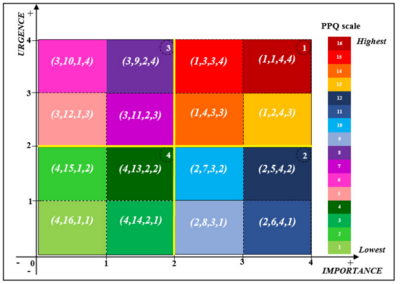
Two decades after the Eisenhower’s matrix, between 1971 and 1975, Thomas L. Saaty developed the Analytic Hierarchy Process, AHP. AHP is a theory and methodology for relative measurement, used to derive ratio scales from both discrete and continuous paired comparisons. It can cover the most basic to the most complex problems presented as a hierarchy with the same structure. No matter what the studied issue is, it should be examined in comparison to other similar entities in such a way that the outcome is less influenced by personal judgement and as objective as possible. Therefore, the AHP focuses on defining priorities, based on the proportions between entities and not their exact measurements. The comparison must be evaluated with a scale of numbers that indicates how many times more important and dominant one element is over another with respect to the criteria or property to which they are compared. [6]
The common point of Eisenhower method and AHP method is that they are both classified as Multi-Criteria Decision Analysis (MCDA), also known as the Multi-Criteria Decision-Making (MCDM), concerned with structuring and solving decision and planning, as well as evaluating multiple conflicting criteria in decision-making. Nevertheless, the Eisenhower matrix is doubtlessly less objective comparing to the Analytic Hierarchy Process with its objective approach. Merging of these 2 methods is based on calculating Priority Quotients (PQs) of analyzed elements, that are next affected into corresponding quadrants of the matrix. [6]
A Priority Quotient (PQ) is calculated for each element by using the following formula:

Then, accordingly to the result of PQs, each element is assigned to the specific quadrant of the matrix in a descending sort. If the matrix does not fulfill the need of the practitioner, a more precise analysis should be conducted. A Partial Priority Quotient (PPQ) may be calculated regarding the needs of the practitioner, for instance using the urgency and importance factor and any other relevant criteria index. Furthermore, the Eisenhower matrix can be split into more precise sub¨matrixes divided into sub-quadrants that ease allocating the analyzed elements. [6]
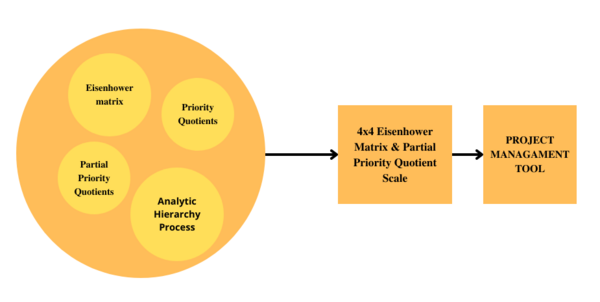
To conclude, merging od the AHP method and the Eisenhower Matrix allows tackling more substential number of activities with bigger complexities. This enables to adress the simplicity of the matrix. Furthermore, the precision of the AHP method assures objectivity.
The Sun Diagram
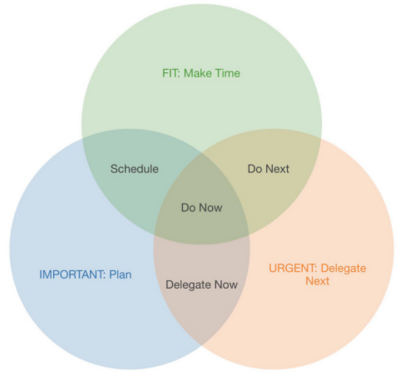
The Eisenhower Matrix may be extended to The Sung Diagram by adding fit. That is, if the agent (e.g., person, company, or group) is required for the task. By adding a third binary variable, the Sung diagram is a suitable representation. The Eisenhower Box reflects on two dimensions, importance and urgency, meanwhile the Venn diagram incorporates a Forgotten Third Dimension of Fitness. The missing element of the Eisenhower Matrix: the fitness for the practitioner to complete the task. The decision for fitness has two components:
- Capability: is the agent the most capable to accomplish this task? Certain tasks require training or practice. In fact, evidence shows that aligning tasks with strengths or capabilities increases productivity and satisfaction. Moreover, the agent must not have the ability to delegate to
someone else who is more trained or practiced.
- Ipseity: does completing this task contribute to one’s ipseity (sense of self)? Does it contribute to one's mission or goal? [5]
Once the decision whether or not the task is important, urgent, and fit have been made, the task is assigned one of the eight outcomes.
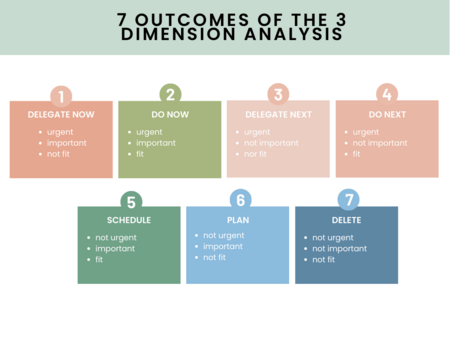
To summarize, expension of the Urgent/Important Matrix by adding a fit factor narrows down the tasks' prioritization by indicating seven, not four categories. It may assist the practitioner to either more precisely prioritize the tasks for themselves or properly delegate them.
Annotated Bibliography
This chapter is aimed at suggesting insightful literature and articles, which discuss The Eisenhower Matrix and prioritization methods in conjuction with the Project, Program, and Portfolio Management standards.
The readings listed below were utilized to write the article and are considered to be the most perceptive towards understanding the Eisenhower Matrix topic:
Project Management: A guide to the Project Management Body of Knowledge (PMBOK guide), 7th Edition
"A reflection on the collaboration and knowledge of working project managers that provides the fundamentals of project management as they apply to a wide range of projects. This internationally recognized standard provides the essential tools to practice project management and deliver organizational results. [2]"
The project managament guidebook recognizes the relevance of prioritization in project management and recommends the use of various prioritization techniques. Another emphasized aspect is the importance of aligning prioritization with project goals and objectives. Project managers are encouraged to prioritize tasks based on their impact on project success and to consider the needs of stakeholders when making prioritization decisions.
Covey, S.R.: The 7 Habits of Highly Effective People: Powerful Lessons in Personal Change
"Few students of management and organization -- and people -- have thought as long and hard about first principles as Stephen Covey. In The Seven Habits of Highly Effective People, he offers us an opportunity, not a how-to guide. The opportunity is to explore ourselves and our impact on others, and to do so by taking advantage of his profound insights. It is a wonderful book that could change your life". -- Tom Peters, author of In Search of Excellence [7]
Overall, "The 7 Habits of Highly Effective People" introduces the Eisenhower Matrix in effective time management and provides practical advice for individuals willing to incorporate the tool into their daily routine. The book emphasizes the need to focus on relevant, but not necessarily urgent tasks in order to be proactive and achieve long-term success.
The Sung Diagram: Revitalizing the Eisenhower Matrix. Diagrammatic Representation and Inference
"The Eisenhower Decision Matrix, credited to the task management system of US President Dwight Eisenhower, is a graphical diagram used in strategy and planning for tasks. This matrix, however, only provides four types of priorities. We identify a collection of scenarios in which the traditional matrix provides misleading suggestions and propose an extension to the matrix that addresses the misleading suggestions illustrated with examples and implementation in a web application" [5]
The article is an academic paper focused on the usage of a diagrammatic representation of the Eisenhower Matrix, the Sung Diagram, to boost the effectiveness of the matrix. The article does address the Eisenhower Matrix as a central tool for time management.
Master the Moment - Fifty CEOs Teach You the Secrets of Time Management
"The tips you’ll find here come from chief executive officers (CEOs) with aggregate responsibility for over a trillion dollars, and millions of people. They took time out of their busy schedules to talk to me about time management and personal effectiveness. Take the time to listen to what they have to say. I’m sure you’ll find this a worth while investment".[3]
The book touches upon the concept of the Eisenhower Matrix and how it can be used to improve time management skills. It also provides examples of how CEOs and other successful leaders use the Eisenhower Matrix to prioritize their tasks and make better use of their time. Additionally, a range of other time management strategies and tips is offered, including techniques to improve focus and concentration, delegate tasks effectively, and reduce distractions.
Other relevant articles, that touch upon Project, Program, Portfolio Managament topics mentioned in this article are listed below:
- AHP as a Decision Making Tool in Projects, Porgrams and Portfolios, by Christian Vindegaard Grønberg
- Project Prioritization in Portfolio Management using Quality Function Deployment", by Stamatia Chatzilazarou
- Applying the Pareto Principle in Risk Management, by Gaia Sassone
http://wiki.doing-projects.org/index.php/Applying_the_Pareto_Principle_in_Risk_Management
References
- ↑ Product Plan, "The-Product-Managers-Complete-Guide-to-Prioritization-by-ProductPlan", 2023.
- ↑ 2.0 2.1 2.2 2.3 2.4 Project Management Institut,"Project Management: A guide to the Project Management Body of Knowledge (PMBOK guide)", 7th edition 2021.
- ↑ 3.0 3.1 Pat Brans, "Master the Moment - Fifty CEOs Teach You the Secrets of Time Management", Pat Brans, 2010
- ↑ 4.0 4.1 4.2 Product Plan, "The Eisenhower matrix" URL: https://www.productplan.com/glossary/eisenhower-matrix/, accessed 6th of February 2023
- ↑ 5.0 5.1 5.2 5.3 5.4 5.5 5.6 Hannah Bratterud, Mac Burgess, Brittany Terese Fas,David L. Millman , Troy Oster, "The Sung Diagram: Revitalizing the Eisenhower Matrix"" 2021 URL:https://www.researchgate.net/profile/Christine-Sung/publication/343686873_The_Sung_Diagram_Revitalizing_the_Eisenhower_Matrix/links/60066bc392851c13fe1f5aa2/The-Sung-Diagram-Revitalizing-the-Eisenhower-Matrix.pdf
- ↑ 6.0 6.1 6.2 6.3 6.4 6.5 Alfred Homère, Ngandam Mfondum, Mesmin Tchindjang, Jean Valery, Mefire Mfondum, Isabelle Makout,"Eisenhower matrix * Saaty AHP = Strong actions prioritization? Theoretical literature and lessons drawn from empirical evidences" 2019 URL:https://www.iaetsdjaras.org/gallery/3-february-880.pdf
- ↑ 7.0 7.1 7.2 7.3 7.4 7.5 7.6 7.7 Stephen R. Covey, "The Seven Habits of Highly Effective People", 1989 URL: https://ati.dae.gov.in/ati12052021_1.pdf
- ↑ 8.0 8.1 8.2 8.3 8.4 8.5 8.6 8.7 Todoist, "The Eisenhower Matrix Avoid the "Urgency Trap" with Dwight D. Eisenhower's famous prioritization framework", URL: https://todoist.com/pl/productivity-methods/eisenhower-matrix#the-eisenhower-matrix-—-urgent-vs-important , accessed 14th of February 2023
- ↑ 9.0 9.1 Famous Authors, URL: https://www.famousauthors.org/stephen-r-covey, accessed 14 February 2023,
